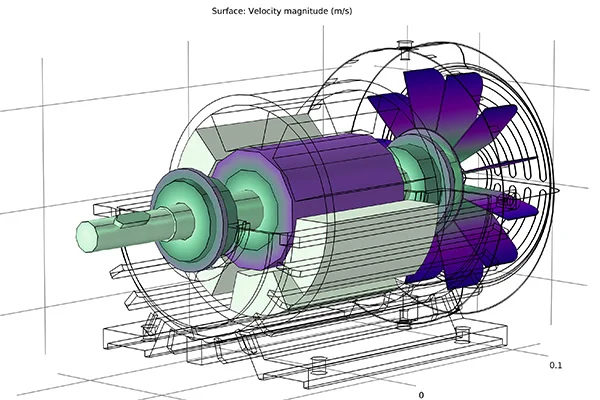The Rise of Global Capability Centers as Enterprise AI Engines
Global Capability Centers (GCCs) have transformed from secondary cost-saving units into central engines of enterprise-wide innovation. These centers have become indispensable, uniquely positioned to accelerate and scale the deployment of AI-powered tools and platforms. According to reports by EY and PwC, the value of work undertaken by GCCs globally could reach US$413 billion by 2030, representing the significant potential of digital-native talent and centralized innovation hubs. One of the key drivers for this growth is the accessibility to capabilities essential for AI success. Why are GCCs the Primary Testbeds for Enterprise AI Access to AI/ML Talent The global AI market size will surpass US$3.6 trillion by 2034 (Precedence Research). However, the access to qualified talent is considered as a top barrier to successful AI implementation, even among ODCs and GCCs. Centers located in talent-rich ecosystems like India have emerged as key solution to this scarcity. Indian GCCs alone have more than 120,000 AI and ML professionals as of 2025, with the demand witnessing a steady growth each year. The number of educational institutes offering artificial intelligence curricula has also surged to a notable extent. For the development and improvement of any AI application, high-quality proprietary data is an essential fuel. Access to such data becomes a significant hurdle for many organizations, where a global capability center partner brings a certain advantage. GCCs, unlike third-party vendors, can operate as fully integrated extension of the client. They function within an enterprise’s predetermined and regulated security perimeter, gathering and utilizing vast, sensitive datasets required to train, fine-tune, and validate sophisticated AI models. It allows teams to develop highly valuable, domain-specific AI agents, such as a diagnostic tool for clinical trial data or a fraud detection model, providing a durable competitive advantage that cannot be replicated easily. In conjunction with the deployment of AI platforms, a new and complex landscape of risks emerges. These include cybersecurity vulnerability, regulatory non-compliance, IP infringement and algorithmic bias. A GCC partner helps establish a centralized risk management center for strengthening security and AI governance. A recent survey by BigID stated that almost 64% of organizations did not have full visibility into their AI risks, exposing them to misuse of data misuse and compliance failures. Under strategic collaboration with a GCC provider, the development and deployment of AI occurs within a dedicated hub, as the enterprise enforces governance frameworks, responsible AI practices and robust cybersecurity protocols. The CapEx requirements for enterprise AI is substantial and multi-layered. Organizations usually face expenses that can quickly escalate, making it difficult to reach a clear ROI. In a GCC, investments are centralized in a single unit, helping companies achieve economies of scale, avoid redundant infrastructure spending and delegate talent acquisition to a dedicated team. As the capital and organizational cost of a risky venture is cut down significantly, a GCC partner makes less expensive innovation possible. It results in the business running more experiments due to a “fail-forward” approach, boosting the probability of achieving breakthroughs in product and reduce time-to-market. Industry 4.0 brought along the need for AI-powered systems, including vision monitoring for industry security, edge computing architecture and digital twin, among others. In affiliation with a capable GCC partner, enterprises can now look to rapidly build advanced automated solutions to ride the emerging wave of Industry 5.0. Industry 5.0 signifies an era where humans work alongside highly-sophisticated technology with more emphasis on human-centricity, sustainability, and resilience. This shift necessitates a combination of talent, technology and innovation which will cause a substantial rise in business costs. A GCC provider can establish a focused lab for R&D, for instance developing a system for running cobots, leveraging their access to pre-built technology stacks and core engineering talent. The cost mitigation resulting from the partnership empowers the parent organization to develop, test, and scale new solutions that are smarter, safer and suited to both customer and workforce needs. How can GCC Partner Accelerate your AI Transformation? The strategic value created by Global Capability Centers in the AI era is best understood through their tangible impact on core business operations. By centralizing resources, a GCC provider alleviates unfavorable costs to acquire AI infrastructure and talent. Their deep engineering roots close the divide between proofs-of-concept and scalable solutions. The future of global capability centers is now invariably linked to the future of enterprise AI, as leading centers aim to pioneer the use of advanced “AI agents” and evolve into autonomous business. Across industries, GCCs are moving beyond theory to spearhead practical, high-value AI deployments teams reshaping customer interactions, optimizing complex processes, and creating new sources of competitive advantage. These centers are not just implementing AI; they are engineering the next generation of business solutions.
Read MoreWhy GCC as a Service is Your New Engine for Global Growth
Global Capability Center as a Service (GCCaaS) represents the next logical phase in the evolution of global business operations. Designed to provide all the benefits of a high-performing, dedicated Global Capability Center, it is a strategic partnership model to help mitigate risks, costs, and delays of the traditional captive approach. In the GCCaaS model, the service partner will take on the end-to-end responsibility of building, operating, and managing a custom capability center. This includes handling all non-core operational complexities—real estate, IT infrastructure, legal compliance, and talent acquisition. It enables the client to maintain tactical control and direct complete focus towards core business objectives. Breaking Free from Capital Constraints: The GCCaaS Advantage The fundamental value proposition of GCCaaS addresses the “Captive Conundrum” for the modern decision maker: Sophisticated GCCaaS offerings can be structured around a “Build, Operate, and Transfer” (BOT) framework. This model provides required flexibility while cutting down the risks associated with the initial setup – a pathway to a fully captive asset after the center has proven its value and stability. For any industrial leader evaluating a strategy for global expansion, the choice is not just between a captive center and traditional outsourcing. GCCaaS is a powerful third option that blends the best of both worlds. Why GCCaaS is the Strategic Imperative for 2025 and beyond? According to NASSCOM, nearly 80% GCCs throughout India drive product development, R&D, and other business strategies today. These services are seen as vital for faster and more effective deployment of AI, IoT and automation across industries. Some of the promising use cases include: For years, the benefits of a Global Capability Center were largely the exclusive to Fortune 500 giants with significant capital strength and risk tolerance. GCCaaS could shatter this paradigm, making world-class global talent and innovation accessible to the dynamic and fast-growing mid-market sector.
Read MoreAutonomous AI Agents vs. Traditional Automation: Boosting Manufacturing ROI with AI
Introduction As the manufacturing sector evolves rapidly, businesses are rethinking their approach to automation. Should they invest in autonomous AI agents for manufacturing process optimization or stick with traditional systems? At the forefront of this transformation is Prescient Technologies, a trusted AI agent development company helping manufacturers leverage the power of AI to achieve greater operational efficiency and long-term ROI. This blog compares the return on investment (ROI) of autonomous AI agents versus traditional automation highlighting how factory automation with AI, driven by Prescient’s advanced solutions, can deliver measurable value over time. What Are Autonomous AI Agents and Traditional Automation? Autonomous AI Agents Autonomous AI agents are intelligent systems designed to adapt, optimize processes, and make data-driven decisions without the need for constant human oversight. Developed by leading AI agent development companies like Prescient Technologies, these agents: Example: AI-driven robotic arms can dynamically change workflows in response to sensor data, enhancing productivity across manufacturing lines. Traditional Automation Traditional automation involves pre-programmed systems like conveyor belts, robotic welders, or PLCs designed for repetitive tasks. While reliable and cost-effective for stable operations, they lack the agility of AI agents. Key Difference: Unlike traditional systems, AI agents developed by Prescient Technologies continuously learn and improve performance unlocking long-term efficiency and adaptability. Why Compare ROI? Choosing between AI-based systems and traditional automation ultimately comes down to ROI. While traditional systems offer lower initial costs, solutions from Prescient Technologies deliver superior performance, lower downtime, and long-term cost-efficiency critical factors in today’s competitive landscape. Key ROI Metrics to Consider ROI Analysis: Autonomous AI Agents Efficiency Gains 40% reduction in setup time through AI-driven manufacturing optimization (Source: McKinsey, 2023). 30–50% drop in unplanned downtime, saving $200K–$500K annually (Source: Deloitte, 2024). 10–20% energy savings, amounting to $50K–$100K per year (Source: IEEE, 2023). These gains are achievable through intelligent systems built by Prescient Technologies, tailored to your factory’s unique requirements. Cost Breakdown Higher upfront investment for AI hardware and data infrastructure. Complexity in implementation, requiring skilled professionals. Expert Insight “Prescient Technologies empowers manufacturers with adaptive AI solutions that go beyond automation boosting real-time decision-making and ROI.” Dr. Jane Smith, AI Manufacturing Expert, MIT (2024) ROI Analysis: Traditional Automation Efficiency Gains Cost Breakdown Expert Insight “Traditional automation offers stability but lacks the dynamic capabilities required in modern, fast-paced manufacturing.” — John Doe, Automation Consultant, Industry 4.0 Summit (2023) Which Offers Better ROI? Short-Term ROI Traditional automation provides faster breakeven, typically in 12–18 months with modest productivity gains. Ideal for factories with limited budgets and fixed process lines. Long-Term ROI AI solutions from Prescient Technologies offer 25% higher ROI over five years through enhanced efficiency, reduced downtime, and predictive capabilities (Source: Gartner, 2023). Example ROI Scenario Investment Type Initial Cost Productivity Increase Annual Maintenance Estimated ROI (5 years) Traditional Automation $100,000 15% $20,000 Moderate AI Agents (Prescient) $150,000 30% $15,000 High Expert Quote “Factory automation with AI scales efficiently offering a clear edge in dynamic environments.” Sarah Lee, Manufacturing Analyst, Forrester Research (2024) Conclusion Whether you’re looking for immediate cost savings or planning for long-term scalability, the choice between traditional automation and AI is strategic. For manufacturers focused on growth, efficiency, and adaptability, Prescient Technologies offers advanced AI agent development that redefines manufacturing ROI. Ready to Future-Proof Your Factory? Partner with Prescient Technologies to design and deploy intelligent AI agents tailored to your manufacturing goals. Whether you’re upgrading legacy systems or starting your Industry 4.0 journey, we’re here to help you maximize your ROI with confidence. Explore Our AI Agent Development Services | Contact Us Today FAQs – Autonomous AI Agents vs. Traditional Automation
Read MoreBuild or Buy? A Guide for Manufacturing Leaders Choosing Application Development Services
Introduction: Choosing the Right Path for Manufacturing Software In the era of Industry 4.0, manufacturing businesses are investing heavily in digital transformation. One crucial question many leaders face is: Should we build a custom software application in-house or buy an off-the-shelf solution? With rising demand for custom manufacturing app development, the answer isn’t always straightforward. Both approaches have their meritsand risks. At Prescient Technologies, we work with leading manufacturers to help them make this strategic decision based on their production environment, business goals, and the software lifecycle in manufacturing. This guide breaks down the pros and cons of each approach, offering a framework to help you decide what’s best for your factory. What Are Application Development Services in Manufacturing? Application development services in manufacturing include the design, development, deployment, and support of software systems tailored to production processes. These could be: Expert Insight: “The software you choose today defines your factory’s agility tomorrow.” Dr. Anita Shah, Digital Transformation Lead, Bosch India Build vs. Buy: A Comparative View Criteria Build Custom App Buy Off-the-Shelf Customization Fully tailored Limited Time-to-Market Slower Fast Upfront Cost High Lower Maintenance Internal Vendor-managed Scalability High May vary Integration Seamless with your stack May require middleware Stat Check: According to Capgemini (2023), 75% of manufacturers using custom-built apps reported improved operational visibility within six months. Key Considerations for Manufacturing Leaders 1. Software Lifecycle in Manufacturing From concept to retirement, software must align with manufacturing’s complex lifecycle: A tailored application from a vendor like Prescient Technologies ensures lifecycle alignment with minimum disruption. 2. Total Cost of Ownership (TCO) When evaluating TCO, factor in: Deloitte (2023) found that custom apps, when aligned with internal processes, lead to 30% reduction in operational inefficiencies over three years. 3. Data Control and Compliance Custom applications offer: Off-the-shelf tools may host your data on third-party clouds or restrict data access. Decision-Making Framework: Build or Buy? Do you need high customization? → Yes → Build ↓ No Do you have limited time-to-market? → Yes → Buy ↓ No Are you planning long-term digital growth? → Yes → Build ↓ No → Buy if you need quick results with less customization. Hybrid Option: The Future of Manufacturing Software More manufacturers today are embracing hybrid approachesbuying a core platform and extending it with custom modules. At Prescient Technologies, our platforms like FactoryConnect™, PowerConnect™, and MachineConnect™ offer API-first architectures. This allows rapid deployment while supporting custom manufacturing app development for specific workflows. You can buy a solid foundation, and build atop it without starting from scratch. Conclusion: Choose a Partner Who Understands Manufacturing The decision to build or buy software in manufacturing isn’t just a technical oneit’s strategic. If you’re aiming for fast deployment and standard functionality, buying makes sense. But for long-term gains, unique processes, and deeper integration, building custom applicationsor leveraging hybrid approachesis often the smarter choice. Prescient Technologies specializes in developing scalable, secure, and future-ready applications for manufacturers.Our domain knowledge ensures a smooth development journey aligned with your software lifecycle and production needs. Let’s Build What Your Factory Needs Get in touch with Prescient Technologies to explore our application development services or discuss a custom manufacturing app project that supports your digital goals. FAQs – Quick Answers for Busy Decision-Makers
Read MoreCAx Software Development for Automotive Design: Enabling Innovation and Efficiency
Table of content Evolution of Automotive Design: From Analog to Digital Realms Enabling Innovation: Pushing Boundaries of Creativity Enhancing Efficiency: Streamlining Design and Development Shaping the Future of Mobility: CAx Software and Beyond Conclusion In the realm of automotive design, the convergence of technology and creativity has revolutionized how vehicles are conceptualized, designed, and manufactured. Central to this transformation is Computer-Aided Design (CAx) software, a vital tool that empowers designers and engineers to visualize, iterate, and refine their ideas in a virtual environment before translating them into tangible vehicles. In this article, we delve into the pivotal role of CAx software development in the automotive design sector, exploring how it drives innovation, enhances efficiency, and shapes the future of mobility. Evolution of Automotive Design: From Analog to Digital Realms Before the advent of CAx software, automotive design was a labor-intensive process reliant on manual sketches, clay models, and physical prototypes. The iterative nature of design required significant time and resources, leading to lengthy development cycles. However, the digital revolution changed the game entirely. CAx software emerged as a transformative tool, allowing designers to create intricate and precise 2D and 3D models on computers. The shift from traditional drafting boards to digital workstations marked a paradigm shift, as it facilitated rapid exploration of design concepts, easy modifications, and collaborative sharing of ideas across teams and geographical boundaries. This digital transformation was a key catalyst for the innovation and efficiency that now define the automotive design landscape. Enabling Innovation: Pushing Boundaries of Creativity CAx software development has propelled innovation in automotive design by providing designers with a canvas where imagination knows no limits. The software’s capabilities extend far beyond mere geometric representations – they enable the integration of engineering, ergonomics, aesthetics, and functionality into a single cohesive design. ● Concept Exploration CAx software empowers designers to explore a wide array of design alternatives quickly and efficiently. Through parametric modeling, designers can manipulate variables such as proportions, dimensions, and features in real-time, instantly visualizing the impact of each change. This flexibility encourages bold experimentation and innovation in vehicle design, as designers can push the boundaries of traditional aesthetics and challenge conventional notions. ● Advanced Visualization Modern CAx tools incorporate realistic rendering and simulation capabilities, allowing designers to visualize materials, lighting, and environmental interactions accurately. This empowers them to make informed decisions about the visual and tactile aspects of the vehicle, resulting in designs that are not just visually striking but also functional and aligned with user expectations. ● Integration of Cutting-Edge Technologies CAx software has evolved to integrate emerging technologies like Virtual Reality (VR) and Augmented Reality (AR). These technologies enable immersive experiences where designers can interact with their designs in virtual spaces. For instance, designers can “walk around” a virtual car, examining its proportions and features from all angles, leading to more comprehensive and insightful design evaluations. Enhancing Efficiency: Streamlining Design and Development Efficiency is at the heart of CAx software’s impact on automotive design. It accelerates the entire design and development lifecycle, from initial concept to final manufacturing, resulting in faster time-to-market and reduced costs. ● Parametric Design One of the key features of CAx software is parametric modeling, which links various design elements together with equations and constraints. This means that when one aspect of the design changes, other related elements adjust automatically. This significantly speeds up the design iteration process, allowing designers to explore numerous possibilities quickly. ● Digital Prototyping CAx software eliminates the need for physical prototypes in the early design stages. Digital prototyping involves creating virtual representations of the vehicle’s components and digitally testing their fit, function, and interaction. This approach reduces the need for costly physical iterations and accelerates the design validation process. ● Collaborative Workflows CAx software enables seamless collaboration between designers, engineers, and other stakeholders, regardless of geographical location. This fosters an environment where multidisciplinary teams can work together in real-time, share feedback, and collectively refine the design. Such collaboration reduces communication gaps and ensures that the final design aligns with both creative and technical requirements. ● Data-Driven Decision Making CAx software generates a wealth of data throughout the design process. Designers can analyze this data to make informed decisions about the design’s feasibility, performance, and manufacturability. This data-driven approach minimizes the risk of design flaws and optimizes the final product for real-world production. Shaping the Future of Mobility: CAx Software and Beyond The trajectory of CAx software development in automotive design continues to evolve, guided by the dynamic landscape of mobility and technology trends. The future promises even more innovation and efficiency, driven by several key areas of development. ● Generative Design This emerging trend leverages Artificial Intelligence (AI) algorithms to explore and generate design options based on specified criteria. The generative design pushes the boundaries of what human designers can conceive by presenting novel design solutions that optimize parameters such as weight, strength, and aerodynamics. This approach will likely revolutionize automotive design by uncovering new possibilities that were previously unexplored. ● Additive Manufacturing Integration As additive manufacturing (3D printing) gains traction in the automotive industry, CAx software will be pivotal in optimizing designs for this manufacturing method. Complex geometries that were once challenging to produce using traditional methods can now be easily manufactured with additive techniques. CAx software will enable designers to create intricate lattice structures, lightweight components, and customized parts that enhance vehicle performance and reduce material waste. ● Sustainability and Electric Mobility The shift towards sustainable and electric mobility will require innovative vehicle designs that accommodate new powertrain technologies and optimize energy efficiency. CAx software will facilitate the integration of battery systems, electric drivetrains, and energy recovery systems into vehicle designs, ensuring that the transition to cleaner mobility is seamless and efficient. ● Human-Centered Design With an increasing focus on user experience, CAx software will evolve to prioritize human-centered design principles. This entails designing vehicles that prioritize safety, comfort, and accessibility for all passengers. Virtual reality and augmented reality tools will enable designers to simulate and optimize the in-car experience, leading to designs that cater to the diverse needs of
Read MoreCAx Software for Simulation and Analysis: Integrating Engineering Tools
Table of content Introduction The Need for Simulation and Analysis in Engineering CAx Software: A Platform for Integration Benefits of Integrating Engineering Tools with CAx Software Challenges in Integrating Engineering Tools with CAx Software Emerging Trends in CAx Software Integration Conclusion Introduction Computer-aided design software has transformed engineering by speeding up the design process and allowing engineers to generate complicated models quickly. However, CAx has capabilities that go beyond design. Engineers can use CAx software for simulation and analysis to study the behavior and performance of designs before manufacturing. This article examines how engineering tools can be integrated with CAx software, highlighting the advantages, difficulties, and new developments. The Need for Simulation and Analysis in Engineering Analysis and simulation are essential components of the engineering design process. They enable engineers to assess numerous design options, spot potential issues, and enhance performance. Engineers can evaluate structural integrity, fluid movement, heat transfer, and electrical behavior. Engineers may improve the overall quality of their designs, lower costs, increase efficiency and make informed decisions. CAx Software: A Platform for Integration CAx software is an ideal platform for integrating simulation and analysis tools. Its extensive capabilities enable widespread use in the engineering industry. Engineers can seamlessly transition from design to analysis without complex data transfers or software interoperability challenges. They can incorporate these tools directly into the CAx environment. Benefits of Integrating Engineering Tools with CAx Software There are several benefits to combining engineering tools with CAx software. These range from incredible teamwork and increased design effectiveness to cost and time savings. Let’s get started and discover how using CAx software and engineering tools may improve your designs: Enhanced Design Iteration Engineers can perform virtual tests and experiments by integrating simulation and analysis tools with CAx software, allowing rapid design iterations. They can quickly evaluate design changes, assess their impact, and refine their models accordingly. This iterative process significantly reduces physical prototyping and testing time and cost. Improved Design Optimization Engineers can more efficiently optimize their designs with CAx software for simulation and analysis tools. They can use cutting-edge algorithms and optimization approaches to alter design parameters for optimal performance automatically. The process is based on predetermined criteria. This integration allows engineers to explore various design options and quickly find the best solutions. Accurate Performance Prediction Simulation and analysis tools integrated into CAx software give engineers accurate predictions of a design’s behavior and performance. Engineers can assess stress distribution, thermal behavior, fluid dynamics, and electromagnetic properties by replicating real-world conditions. This knowledge helps engineers identify potential weaknesses and make necessary improvements before manufacturing, ensuring better overall performance and reliability. Seamless Data Exchange Integrating CAx software for simulation and analysis tools ensures seamless data exchange between different engineering domains. Engineers can transfer design parameters, geometric information, and simulation results between various analysis modules within the CAx environment. This integration promotes collaboration, improves data consistency, and eliminates the need for manual data translation or re-entry, reducing the chances of errors. Challenges in Integrating Engineering Tools with CAx Software A unique set of difficulties arises while navigating the complex environment of CAx software integration with engineering equipment. Let’s look at some of the significant obstacles and possible solutions to get through them so that the integration process runs smoothly and successfully: Complex Software Architecture Integrating simulation and analysis tools within CAx software requires a complex software architecture that can handle the diverse requirements of different engineering domains. Software developers face significant challenges in ensuring smooth communication between CAx and analysis modules, data synchronization, and maintaining a user-friendly interface. Interoperability Issues Different vendors often develop CAx software for simulation and analysis tools, resulting in interoperability challenges. Standardization efforts, such as the STEP (Standard for the Exchange of Product Data) format, have helped mitigate these issues. However, further collaboration and standardization initiatives are required to ensure seamless integration and data exchange between software tools. Computational Requirements Simulation and analysis processes can be computationally intensive, requiring substantial computational resources. Integrating these tools within CAx software necessitates optimizing performance, memory management, and scalability to efficiently handle large and complex models. This challenge becomes more significant as engineers demand faster simulations and analyses to meet tight project deadlines. Emerging Trends in CAx Software Integration CAx software integration is changing due to some intriguing new trends. These developments rethink how engineers approach design and analysis and present new opportunities. Let’s investigate the most recent developments that are elevating CAx software integration to new levels: Cloud-Based Solutions Cloud computing offers a promising solution for CAx software integration by providing scalable computational resources and collaborative environments. Cloud-based CAx platforms enable engineers to access simulation and analysis tools remotely. It reduces the burden on their local machines and facilitates real-time collaboration among team members. Integration of Artificial Intelligence (AI) CAx software’s inclusion of AI algorithms improves simulation and analysis capabilities. AI can optimize designs, automate complicated operations, and increase the precision of predictions. Machine learning approaches might advise design alterations based on simulation findings. Advanced technical analysis and optimization are now possible thanks to the combination of AI and CAx software. Multi-Disciplinary Optimization Multi-disciplinary optimization features are being added to CAx software to address the increasing complexity of engineering systems. Engineers may optimize designs simultaneously for numerous domains because MDO integrates several analysis modules. Engineers may use this method to investigate intricate design spaces, weigh trade-offs between several disciplines, and produce comprehensive design solutions. Conclusion CAx software has significantly developed from a simple design tool to a complete simulation and analysis platform. Engineers can easily switch from design to analysis by integrating engineering tools into the CAx environment, streamlining the product development process. Enhanced design iteration, better optimization, precise performance forecasting, and seamless data interchange are some advantages of this connection. However, issues with software architecture, interoperability, and computational needs must be resolved to fully utilize the potential of CAx software for simulation and analysis. The future of CAx software integration looks bright with growing trends, including cloud-based solutions, AI integration, and multi-disciplinary optimization, promising even
Read MoreMastering CAx Software Development: Tips and Best Practices for Efficient Design
Table of content Introduction What exactly is CAX software development? CAX Software: A Platform for Integration Tips and Best Practices for Efficient Design Conclusion Introduction The way engineers and designers build, evaluate, and visualize their products are completely transformed by computer-aided design (CAx) software. The complex realm of CAx software development plays a vital role in these potent CAx applications. This article will enable you to produce effective and reliable design tools by mastering CAx software development. These insights will help you build your skills and provide great CAx solutions. It’s perfectly suitable, irrespective of whether you are an experienced CAx software developer or just beginning your path. What exactly is CAx software development? The development of CAx software entails producing computer-aided design instruments used to construct, examine, and visualize items. It’s all about creating software programs that support streamlined design workflows, accurate 3D modeling, interactive visualization, and system integration. The below skills are needed in the development of CAx software: Creating effective CAx software equips users to increase productivity, rationally choose designs, and accelerate product development. . Tips and Best Practices for Efficient Design A thorough understanding of CAx software development is vital for your design skills to achieve maximum potential. By following key points, you can tap the true potential of CAx software development and improve your design abilities. Understand User Needs and Workflows Understand the needs and workflows of the end users thoroughly to produce efficient CAx software. Engage engineers, designers, and business experts to learn more about their difficulties, pain areas, and expectations. This understanding can help you create features and functionalities that meet customer needs, resulting in a more user-friendly and effective CAx system. Study common design workflows and identify areas where automation and optimization can provide significant value. Streamlining repetitive tasks, integrating intelligent design assistants, and incorporating simulation capabilities are some ways to enhance user productivity. Maintain Modularity and Scalability CAx software development often involves complex systems with numerous components and interdependencies. Adopt a modular architecture approach to ensure maintainability and scalability. Break down the software into independent modules or libraries, each responsible for specific functionalities. Better code organization, code reuse, and easier debugging and upkeep are all made possible by modularity. It also makes it possible for collaborative development, which quickens the entire development cycle by allowing numerous developers to work on various modules simultaneously. Additionally, it’s important to design the CAx software with scalability in mind. Anticipate future growth and changing requirements and build a flexible architecture to accommodate new features and adapt to evolving technology trends. This forward-thinking approach will prevent architectural bottlenecks and enable seamless expansion of the CAx software’s capabilities. Optimize Performance and Efficiency Efficient design tools must perform at their peak to handle intricate 3D models, big assemblies, and computationally demanding activities. The main goal of CAx software development should be performance optimization. Reduce computing complexity and memory utilization by using algorithms and data structures. Use approaches like spatial indexing, effective mesh representations, and level-of-detail algorithms to ensure quick rendering and easy interaction with the CAx models. Utilize the power of contemporary hardware by using multithreading and parallel processing. You can use several CPU cores and GPUs for quicker computations. The user experience can be further improved through asynchronous processing and background jobs. They can deliver responsive interfaces even during computationally demanding operations. Prioritize Visualization and Interactivity The capability of CAx software to offer interactive visualization and immersion is a vital feature. Users rely on precise and thorough representations of their concepts to make wise judgments. Therefore, create powerful rendering systems to manage accurate material, lighting, and shading attributes. Implement interactive controls and clear user interfaces that simplify a 3D model modification, annotation, and navigation. Include tools that let users examine your designs from different angles. Some options are dynamic zooming, panning, rotation, and sectioning. Additionally, it supports advanced visualization techniques, including transparency, reflections, and animations. All these provide a rich and engaging user experience. Real-time feedback during design modifications is crucial for efficient iterations and quick decision-making. Embrace Open Standards and Integration CAx software rarely operates in isolation. It often needs to interact with other software systems and exchange data with external tools. Embrace open standards and interoperability to integrate with commonly used file formats, industry-specific standards, and collaboration platforms. Support file import/export in common formats, including STEP, IGES, and STL, to ensure interoperability with various CAx systems and manufacturing procedures. Create APIs and SDKs that let outside developers add features to your CAx program or incorporate it into broader software ecosystems. Utilize existing libraries and frameworks for performing typical CAx tasks. You can also use it to collaborate with industry groups and communities to maintain current standards. Your CAx solution can benefit from integrating analysis tools, simulation software, and data management systems. Implement Robust Error Handling and Debugging As with any software development, CAx software can encounter errors and bugs during usage. Implementing robust error-handling mechanisms and effective debugging tools is essential to ensure a smooth user experience. Incorporate comprehensive error-handling routines that provide informative error messages and gracefully handle unexpected scenarios. Proper error reporting allows users to understand the issue and take appropriate actions to resolve it. Additionally, create debugging tools that help programmers locate and resolve software bugs. Logging methods, debuggers, and diagnostic tools help trace the execution flow, examine variables, and identify the main source of failures. You may improve the dependability and stability of your CAx software, which will boost user satisfaction. It also requires less support and maintenance work by prioritizing error handling and debugging. Conclusion Mastering CAx software development requires combining technical expertise, understanding user needs, and adherence to best practices. You can create efficient and powerful CAx tools that empower engineers and designers to bring their visions to life by: Strive for continuous learning, stay abreast of emerging technologies, and embrace innovation. Push the boundaries of CAx software development and shape the future of digital design. Ready to take your CAx software development skills to the next level?
Read MoreBusiness Process Automation Success Stories: Streamlining Workflows with CAx
Table of content Introduction Understanding Business Process Automation Business Process Automation with CAD Streamlining Workflows with CAD: Success Stories Conclusion Introduction Industries across the board are continuously looking for ways to improve operational efficiency and productivity in today’s fast-paced corporate environment. Computer-Aided Design (CAD) is one potent tool that has changed numerous industries. CAD technology, which was first created to help with the creation, modification, and optimization of designs, has advanced to play a large part in business process automation. Businesses have effectively optimized their operations by using business process automation with CAD software, which has enhanced productivity, decreased costs, and raised customer satisfaction. This article explores several success stories of organizations that have harnessed the power of CAD to achieve business process automation and reap its benefits. Understanding Business Process Automation The term “business process automation” (BPA) describes how repetitive operations, activities, and workflows are streamlined and automated inside a company. It entails the use of software systems or tools that can carry out typical tasks with little assistance from humans, hence lowering error rates, boosting productivity, and conserving time and resources. Robotic process automation (RPA), workflow automation, and artificial intelligence (AI) are a few examples of technologies that are generally integrated into business process automation (BPA) in order to improve corporate operations, boost productivity, and free up employees’ time for higher-value tasks. Business Process Automation with CAD Streamlining workflows and improving business processes are two related concepts in the context of business process automation (BPA) and computer-aided design (CAD). Organizations are able to swiftly and accurately produce, alter, and visualize product designs because of the critical role that CAD software plays in automating design-related procedures and activities. Integrating CAD with BPA tools and systems offers numerous advantages for businesses. By automating the transfer of design data and streamlining manufacturing processes, organizations can enhance efficiency, facilitate collaboration, and minimize errors. This seamless connection enables smooth data interchange and communication, resulting in improved productivity across diverse industries such as manufacturing, automotive, architecture, and product development. Additionally, the integration of CAD and BPA tools reduces the time to market, allowing businesses to bring their products or designs to market faster and gain a competitive edge. Streamlining Workflows with CAD: Success Stories By examining real-world examples, we can gain insights into how CAD has revolutionized various sectors, enabling them to overcome challenges, enhance collaboration, and achieve impressive results. Let us explore some success stories and uncover the transformative impact of CAD that streamline workflow for automation. Automotive Industry The auto industry is fiercely competitive, as manufacturers compete to produce cutting-edge designs, shorten time to market, and improve manufacturing techniques. Automotive companies have benefited greatly from using CAD software to improve productivity and acquire a competitive edge. One notable success story is that of Tesla, the electric vehicle pioneer. Tesla extensively utilizes CAD software throughout its product development lifecycle. By digitizing their design processes, Tesla has achieved remarkable efficiencies in their engineering workflows. CAD enables the design team to quickly iterate and test various design concepts, leading to faster product development cycles. Additionally, CAD enables seamless collaboration between different teams, such as design, engineering, and manufacturing, ensuring efficient communication and reducing errors. As a result, Tesla has been able to introduce cutting-edge electric vehicles to the market faster than traditional automakers. Architecture and Construction The architecture and construction industry heavily relies on precise designs and efficient project management. CAD has significantly transformed this sector by automating various processes, from initial design creation to construction documentation. One remarkable success story is the Burj Khalifa in Dubai, the tallest building in the world. CAD played a crucial role in the construction of this architectural marvel. Through CAD software, the project’s architects and engineers were able to create detailed 3D models of the building, allowing them to visualize the structure and identify potential design flaws before construction began. This early detection of issues saved significant time and resources, ensuring a smoother construction process. Moreover, CAD facilitated effective collaboration among the project teams, architects, and contractors, enabling seamless communication and reducing costly rework. The successful completion of the Burj Khalifa is a testament to CAD’s power in automating and streamlining complex construction projects. Manufacturing and Industrial Processes For businesses looking to maximize productivity, decrease errors, and cut costs, efficient manufacturing and industrial processes are essential. CAD has transformed these industries by automating the design, prototype, and manufacturing processes. A notable success story comes from General Electric (GE), a global conglomerate in the manufacturing and industrial sectors. GE employs CAD software extensively in its turbine manufacturing division. By utilizing CAD, GE has been able to automate the design and optimize the role of turbine components. CAD enables engineers to create 3D models of turbine parts, simulate their performance under different conditions, and iterate designs to achieve optimal efficiency. This automation significantly reduces design and testing time, allowing GE to bring new turbine models to market faster. Additionally, the seamless transfer of design data to the production floor is made possible by CAD integration with computer-aided manufacturing (CAM) software. This results in an accurate manufacturing process and lowers errors. The use of CAD for business process automation by GE has increased productivity while also enhancing the functionality and dependability of their turbine products. Product Development and Prototyping CAD has been a game-changer for organizations engaged in product development and prototyping. It enables businesses to rapidly create, modify, and visualize product designs, accelerating time-to-market and reducing costs associated with physical prototyping. One notable success story is that of Dyson, a leading innovator in the home appliance industry. Dyson heavily relies on CAD software to design and develop their innovative products, such as vacuum cleaners and hair dryers. CAD enables Dyson’s engineers to quickly create virtual prototypes, simulate their functionality, and make necessary design iterations. This agile design process saves significant time and resources compared to traditional prototyping methods. Moreover, CAD facilitates seamless collaboration between design and engineering teams, enabling efficient communication and reducing errors during the product development phase.
Read MoreCAD Software Development for Automotive Simulation: Accelerating Design Validation
Table of Content Introduction The Role of CAD Software in Automotive Simulation Challenges and Future Trends The Role of CAD Software in Sustainable Automotive Design Conclusion Introduction The automobile sector has always been on the cutting edge of technical development, continually pushing the envelope of innovation. Design validation ensures that new vehicle designs adhere to safety, performance, and legal criteria and is essential to automotive development. Computer-aided design (CAD) software, integrated with KBE principles, has revolutionized automobile simulation, significantly expediting the process and enhancing accuracy. Knowledge-based engineering incorporates design rules, engineering knowledge, and optimization algorithms into CAD software, empowering engineers to automate and streamline the design validation process. In this post, we’ll look at the importance of CAD software development in the automobile sector and how it affects design validation. The Role of CAD Software in Automotive Simulation Computer-aided design (CAD) software enables automotive engineers and designers to create, modify, and analyze vehicle components and systems in a virtual environment. By utilizing CAD software, automotive manufacturers can simulate various scenarios and evaluate the performance and behavior of different design options before physically building prototypes. This virtual prototyping process significantly accelerates design validation by identifying potential issues early in the development cycle. Let’s explore the key points highlighting how CAD software expedites the design validation process, enhances accuracy, promotes collaboration, and ultimately drives efficiency in automotive design and development. Let’s dive in and discover the power of CAD software in accelerating design validation. CAD software offers advanced visualization capabilities, allowing designers to create highly realistic 3D models of vehicles and their components. This level of visual fidelity enables engineers to examine the design from multiple angles and identify potential clashes, interferences, or design flaws. By detecting these issues early, the development team can make necessary adjustments swiftly, saving time and resources. CAD software offers potent simulation tools that allow testing and analyzing car designs virtually. Crash tests, aerodynamic performance, structural integrity, and thermal analysis are real-world situations that engineers can model. These simulations enable design modifications to improve safety, efficiency, and overall performance by demonstrating how the vehicle might behave in various conditions. By leveraging CAD software, designers gain the ability to make design modifications and evaluate their impact on the final product. This approach significantly reduces the time required compared to manual prototyping methods. The design validation process is greatly accelerated with the ability to test multiple iterations, assess their viability, and implement necessary improvements. The iterative nature of CAD empowers designers to expedite the development cycle and enhance the overall efficiency of product design and validation. CAD software enables seamless collaboration and communication among various stakeholders in the design validation process. Designers, engineers, and manufacturers can work together on a virtual platform, sharing design files, annotating, and providing real-time feedback. This collaborative environment improves efficiency, reduces miscommunication, and ensures everyone is on the same page, further expediting the design validation process. CAD software development for automotive simulation is crucial in reducing development costs. By identifying design flaws and issues early in the virtual prototyping stage, manufacturers can avoid expensive physical prototypes and costly rework. CAD software enables engineers to optimize designs for manufacturability, assembly, and materials, leading to cost savings during production. Challenges and Future Trends A thorough understanding of CAD software development is vital for your design skills to achieve maximum potential. By following key points, you can tap the true potential of CAD software development and improve your design abilities. CAD software must advance to handle the delicate relationships between many components as vehicle systems become more complex. A fluid workflow and accurate design validation depend on integration with other software tools, such as computer-aided engineering (CAE) and computer-aided manufacturing (CAM). The automotive industry is moving towards real-time simulation, where virtual testing can be performed accurately and quickly. CAD software developers must enhance simulation capabilities to provide real-time feedback during the design process, enabling faster iterations and better decision-making. VR and AR technologies VR and AR technologies can revolutionize the design validation process. By immersing designers and engineers in virtual environments, CAD software can provide an enhanced understanding of the design and its performance. Incorporating VR and AR capabilities into CAD software will offer a more intuitive and immersive experience, leading to better design decisions. Automation of some steps in the design validation process is possible with the help of AI and ML algorithms. AI-driven algorithms, for instance, may examine a lot of simulation data to find patterns, refine designs, and provide suggestions for enhancements. It’s possible to hasten the design validation process and increase overall efficiency by integrating AI and ML capabilities into CAD software. Effective data management and security have become crucial with the increasing reliance on digital design data and collaboration. CAD software development must address challenges related to data organization, version control, and secure data sharing among different stakeholders. Implementing robust data management systems and ensuring data security protocols will be paramount to protect valuable intellectual property and maintain confidentiality. The Role of CAD Software in Sustainable Automotive Design With an increasing focus on sustainability in the automotive industry, CAD software enables sustainable design practices. By facilitating virtual prototyping and simulation, CAD software reduces the need for physical prototypes, thus minimizing material waste and carbon footprint. The accurate analysis provided by CAD software helps optimize designs for energy efficiency, lightweight, and eco-friendly materials. Additionally, CAD software promotes team collaboration and communication, enabling seamless integration of sustainability considerations throughout the design validation process. Through its capabilities, CAD software empowers automotive manufacturers to embrace sustainable practices and develop environmentally conscious vehicles for a greener future. Conclusion The emergence of automotive simulation CAD software integrated with Knowledge-Based Engineering (KBE) is pivotal in accelerating design validation processes. This advanced CAD software equips automotive engineers and designers with a wide range of tools and functionalities to expedite development timelines and reduce costs. It empowers them to streamline design validation, improve efficiency, and deliver high-quality automotive solutions in a cost-effective and time-efficient manner. As technology continues to advance, KBE-driven CAD software addresses challenges. It embraces future trends like real-time
Read MoreThe Future of CAD: Trends and Innovations in Product Development
Table of Content Introduction What exactly is Computer-Aided Design? Trends and Innovations in Product Development Conclusion Introduction Cutting-edge trends and breakthrough technology are driving the future of CAD, which is poised to revolutionize product development. CAD systems are getting more sophisticated and intuitive as artificial intelligence and machine learning become more prevalent, allowing designers to easily produce complicated designs. Virtual and augmented reality is changing how products are visualized and verified, allowing for immersive and interactive design experiences. The vision-based inspection system is one remarkable breakthrough in this developing landscape, utilizing the power of computer vision to automate quality control procedures, ensuring precise and error-free manufacturing. The future of CAD is one of boundless possibilities, ushering in a new era of product development. In this article, we will examine what computer-aided design (CAD) is, the new trends and breakthroughs influencing CAD’s future and how they affect the creation of new products. What exactly is Computer-Aided Design? Computer-Aided Design (CAD) is a game-changing technology that allows designers and engineers to realise their creative concepts. It is a digital design technique that substitutes old manual drawing methods to create precise, accurate, and efficient 2D and 3D models. CAD software offers a strong collection of tools that allow designers to easily see, analyse, and alter their designs. Complex geometries can be easily changed, prototypes can be simulated and tested, and designs may be optimized for manufacturing using CAD. CAD transforms the design workflow, increasing productivity, collaboration, and overall product quality. Trends and Innovations in Product Development Product creation is undergoing a transition as a result of technological breakthroughs in the quickly changing environment of today. The industry is undergoing groundbreaking breakthroughs transforming how we produce and optimize products, from cloud-based collaboration to AI-driven design. Let’s explore the latest trends and innovations revolutionizing the industry. Cloud-Based CAD The move to cloud-based solutions is one of the most important developments in CAD. Comparing cloud-based CAD platforms to traditional desktop software reveals several benefits. They enable real-time collaboration, so several team members can simultaneously work on the same project. Generative Design Generative design is a cutting-edge methodology that uses artificial intelligence (AI) algorithms to provide a variety of design possibilities based on a predetermined set of criteria. The software may explore various alternatives and produce optimised solutions by providing design goals and limitations. With the help of this technology, designers can investigate unusual concepts and find creative solutions that could not have been considered otherwise. The development of new products can move more quickly thanks to generative design, which can also cut down on material waste and improve performance. Integration with Virtual Reality (VR) and Augmented Reality (AR) Technologies for virtual reality (VR) and augmented reality (AR) have become very popular in recent years. By enabling designers and engineers to engage with virtual models more naturally and realistically, these immersive technologies add new dimensions to CAD. Insights into ergonomics, spatial relationships, and overall aesthetics can be gained by allowing users to visualise and experience a design in a simulated environment using virtual reality (VR). Contrarily, AR superimposes virtual models over the real world to enable real-time design changes and the ability to see how a product fits into its surroundings. The design review process might be revolutionized, cooperation could be improved, and decision-making could be enhanced by integrating CAD with VR and AR. Parametric and Feature-Based Modeling For many years, parametric modelling has been a mainstay of CAD software. It enables effective adjustments and updates by allowing designers to specify relationships between various design elements. By incorporating several characteristics, feature-based modelling advances parametric modelling by capturing design intent. Rapid design iterations are possible by changing or suppressing these aspects. Further developments in parametric and feature-based modelling will be made in CAD, making it simpler for designers to construct complicated designs and modify them in response to shifting requirements. Additive Manufacturing (3D Printing) The field of additive manufacturing, also called 3D printing, has expanded rapidly in recent years. CAD plays a significant part in this process by supplying digital models that are transformed into actual products. More additive manufacturing technologies will be integrated with CAD in the future, allowing designers to optimise designs specifically for 3D printing. This includes lattice structures, lightweight constructions, and intricate geometries that were previously impossible or difficult to create using conventional techniques. Numerous industries, including aerospace, healthcare, and automotive, will continue to transform due to the convergence of CAD and additive manufacturing. Artificial Intelligence and Machine Learning Various industries, including CAD, are experiencing radical change due to artificial intelligence (AI) and machine learning (ML). Large-scale design data analysis, pattern recognition, and recommendation generation are all capabilities of AI algorithms. This can help designers make wise judgements and enhance the entire design process. Predictive models for design optimization, cost estimate, and performance analysis can also be created using machine learning algorithms trained on already-existing design data. By integrating AI and ML into CAD software, designers can take advantage of data-driven insights, automate tedious activities, and improve creativity. Internet of Things (IoT) Integration A network of networked devices that gather and share data is known as the Internet of Things (IoT). CAD software will progressively interface with IoT platforms as IoT technology develops. Thanks to this connection, designers will be able to construct linked, smart items. Engineers may collect real-time data on product performance, usage trends, and maintenance requirements by embedding sensors and connectivity into their designs. Then, with the help of this information, future designs, user experiences, and preventive maintenance may all be enhanced. Conclusion The development of products could be drastically altered thanks to CAD. CAD will become more potent, available, and user-friendly as technology advances, enabling designers and engineers to produce cutting-edge, environmentally responsible goods in a market that is getting more competitive. For organizations looking to maintain their position at the forefront of product development in the years to come, embracing these trends and utilizing CAD skills will be essential. Experience the future of CAD with Prescient: Unlock innovative
Read More








